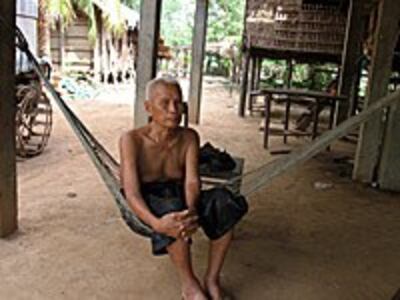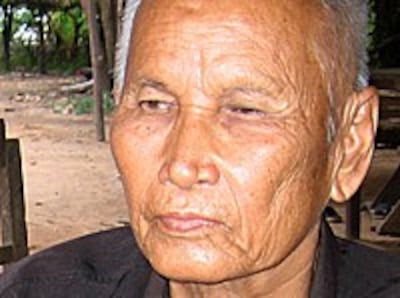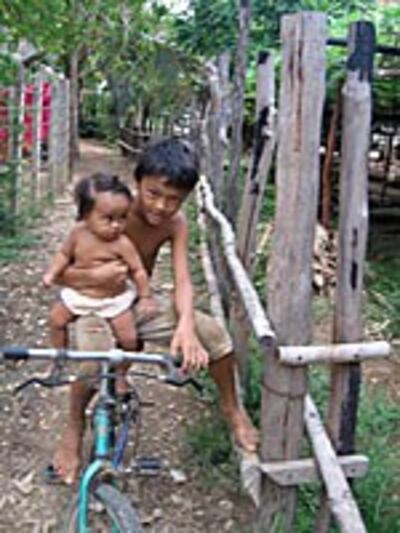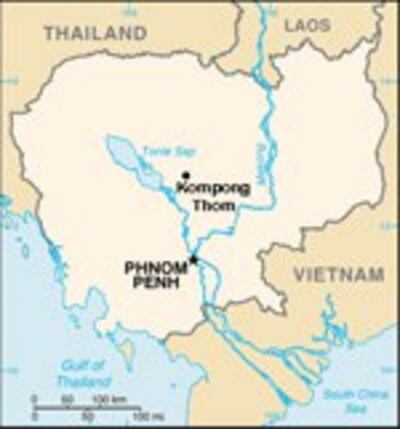Fourth in a series
Prek Sbauv Village, Cambodia

The war is over. The Khmer Rouge have come and gone. And life in this village now goes on much as it did some 40 years ago before Cambodia began its spiral into civil war, American bombing, widespread executions, forced labor, starvation, and Vietnamese occupation.
Saloth Nhep, brother of the late, infamous Cambodian leader Pol Pot, is the only surviving close relative of the man responsible for the deaths of as many as 2 million Cambodians.
At age 80, Nhep admits he remembers little about Pol Pot beyond his early childhood. What he does recall is a “gentle boy” who wouldn’t harm a fly.
Nhep says he knew nothing of his brother’s political activities. He was surprised, he says, when the first photograph of the Khmer Rouge leader was posted in his village’s communal dining room after the Khmer communists came to power in April 1975.
Only in 1976 did the secretive Khmer Rouge reveal the identity of its leader, Pol Pot, whose real name was Saloth Sar.
“I was surprised when I heard that he killed people,” says Saloth Nhep.

Pol Pot’s home village suffered greatly during the war. A U.S. fighter-bomber dropping napalm destroyed the home on stilts where he and Nhep were born. His family sold the plot of land on which the house stood. It is now planted with palms and mango and cashew trees.
Nhep’s children built a new house of wood and thatch just off the main road through the village, next to the muddy Sen River and about three miles south of the provincial capital Kompong Thom. The village is located some 100 miles (165 kms) north of the national capital of Phnom Penh.
Some Cambodians say that the bombing, which was intense in this part of Cambodia, sparked hatred for the Americans and the Lon Nol government, making it easier for the Khmer Rouge to recruit new soldiers.

But Nhep says that this wasn’t the case in his village, where many young men joined the Lon Nol forces.
“Most people in the village didn’t support one side or the other,” he says. “We just tried to survive.”
In the end, the Khmer Rouge brought little permanent change to Pol Pot’s village. The village has returned to conditions much as they were before the Khmer Rouge fought their way to power.
Rice farming continues as before, with little of the mechanization that Pol Pot called for but failed to achieve. Money and markets, abolished by Pol Pot, are back. And so is what he would have called “reactionary religion.”
After the war ended, missionaries constructed a Roman Catholic church and an evangelical Christian church in the village. A Buddhist temple has been renovated.
“People have turned to Christ because they are poor,” says Saloth Nhep.
Nhep bears a striking resemblance to Pol Pot--the same light skin, prominent cheekbones, and deep-set eyes. Pol Pot was said to have had a lovely smile, but Nhep doesn’t smile very much.
He makes clear that he disagreed with his brother’s policies.

Asked if it was true, as one villager alleged, that he got financial help from Pol Pot in order to build a new house, he insists that’s simply untrue. For one thing, he says, his new home, is not as large or sturdy as some others in the area.
“If I’d been connected with Pol Pot, if I’d received any help from him, I wouldn’t be able to survive in this village,” says Nhep. “The people here were outraged over what he did.”
